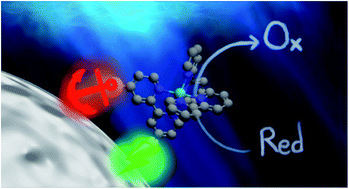Cooperative silanetriolate-carboxylate sensitiser anchoring for outstanding stability and improved performance of dye-sensitised photoelectrodes†
Abstract
Photosensitising dyes require anchoring groups for attachment to a metal oxide support surface. When a dye-sensitised electrode is designed for applications in aqueous media, e.g. for photoelectrocatalytic water splitting, these anchoring groups must be highly stable towards hydrolysis while retaining sufficient electrical conductivity to sustain efficient transfer of photogenerated charges. With this motivation, we introduce herein a cooperative silanetriolate-carboxylate anchoring combination. A ruthenium(II) tris-bipyridine dye has been functionalised with this dual-anchor through a facile peptide coupling reaction. The photoelectrooxidation performance and stability of mesoporous TiO2 electrodes sensitised with this new dye have been systematically examined in solutions with pH 1–9 in the absence and presence of a sacrificial electron donor and/or buffering electrolyte following a specifically designed testing protocol, which involves comprehensive characterisation of the electrodes and electrolyte solutions by ICP-MS and UV-vis spectroscopy. When compared to the state-of-the-art phosphonate anchoring group, the silanetriolate-carboxylate combination enables approximately 4- and 8-fold enhancements in the rate of sulphite oxidation by the Ru(II) (bipyridine)3-sensitised TiO2 photoanodes under 1 sun irradiation after 2 and 24 hours of reaction, respectively. In the absence of a sacrificial electron donor, photoanodes based on carboxylate- and phosphonate-anchored dyes undergo continuous and rapid degradation under all conditions examined, leading to almost completely bleached electrodes within less than an hour of operation. Conversely, silanetriolate-carboxylate anchoring provides quasi-stable operation with typically less than 10% ruthenium loss from the electrode surface under the same conditions. The analysis undertaken here unambiguously attests to the significantly improved long-term performance of the dye-sensitised photoelectrodes provided by the cooperative anchoring system where silanetriolate provides high stability and carboxylate sustains efficient charge transfer. This furnishes a practical pathway towards the synthesis of photosensitisers capable of stable and efficient operation within photoelectrochemical devices in aqueous environments.



 Please wait while we load your content...
Please wait while we load your content...